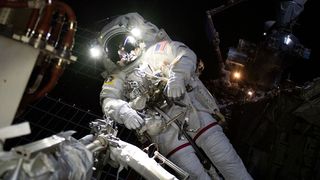Russian space debris forces space station to dodge, delays US spacewalk
The Russian space junk is part of an old Fregat upper stage and passed within a quarter-mile of the station at 11:17 a.m. ET.
NASA delayed a planned spacewalk to venture outside the International Space Station at the last moment on Wednesday after a large piece of Russian space debris came dangerously close to the orbital outpost.
NASA astronauts Frank Rubio and Josh Cassada were getting ready to step out from the U.S.-built Quest airlock on the International Space Station early Wednesday (Dec. 21) to install new solar arrays when their Mission Control team commanded them to halt the work. Instead, the space station will perform an emergency maneuver to get out of the way of a large piece of space debris that is on track to get dangerously close to the lab later in the day. The spacewalk was ultimately rescheduled for Thursday, Dec. 22.
The debris in question is a piece of a Russian rocket, the 11-foot-wide (3.35 meters) Fregat upper stage used on Soyuz and Zenith launchers. The junk was predicted to get within less than a quarter of a mile (0.4 kilometers) from the station later today, triggering a "red," highest-level warning, Dan Huot, NASA spokesperson at Mission Control at the Johnson Space Center in Houston, said during live commentary.
Related: International Space Station: Live updates

"This is a piece of debris that's been tracked over the last couple of days and its tracking data was always in our green or yellow range, which doesn't necessitate doing a maneuver," Huot said. "But this morning, it moved to red, and once we get into red, we have to take action, whether it's a debris maneuver or some other precautionary measure to help keep the crew safe."
The decision to cancel the spacewalk was made at around 5 a.m. EST (1000 GMT), Huot added. The ground control team is now preparing to steer the station to safety using thrusters aboard Russia's Progress cargo spacecraft that is currently docked to the station's Russian segment. The maneuver is expected to take place at 8:42 a.m. EST (1342 GMT).
Huot said that the space station is in no danger from the debris, which was predicted to make its closest approach to the space lab at 11:17 a.m. EST (1617 GMT).
Get the Space.com Newsletter
Breaking space news, the latest updates on rocket launches, skywatching events and more!
NASA will look for a new slot for the needed spacewalk, which might take place later this week.
"The crew is going to have to replan their schedule for the day so they don't expect to see a spacewalk today," Huot said. "The crew is not in danger. This is not the first time we've done this and won't be the last. This is just about some of the realities of operating in low Earth orbit."
The incident comes about a week after a significant coolant leak from Russia's Soyuz crew capsule, which brought NASA's Frank Rubio and Russian cosmonauts Sergey Prokopyev and Dmitry Petelin to the space station in September. The leak, which may have rendered the capsule unsafe to fly astronauts home, was blamed on a piece of space debris or a meteorite by experts, although a formal investigation is still underway.
If the concerns are confirmed, the space station might be for the first time in its history without a capability to bring its entire crew safely home in case of a serious incident aboard.
"Never a dull day aboard the International Space Station," Huot said.
Editor's note: This story was updated at 4 p.m. EST to note that NASA has rescheduled the spacewalk for Thursday, Dec. 22. You can watch the spacewalk live online, courtesy of NASA TV, beginning at 7 a.m. EST (1200 GMT). The spacewalk will begin at 8:30 a.m. EST (1330 GMT).
Follow Tereza Pultarova on Twitter @TerezaPultarova. Follow us on Twitter @Spacedotcom and on Facebook.
Join our Space Forums to keep talking space on the latest missions, night sky and more! And if you have a news tip, correction or comment, let us know at: community@space.com.

Tereza is a London-based science and technology journalist, aspiring fiction writer and amateur gymnast. Originally from Prague, the Czech Republic, she spent the first seven years of her career working as a reporter, script-writer and presenter for various TV programmes of the Czech Public Service Television. She later took a career break to pursue further education and added a Master's in Science from the International Space University, France, to her Bachelor's in Journalism and Master's in Cultural Anthropology from Prague's Charles University. She worked as a reporter at the Engineering and Technology magazine, freelanced for a range of publications including Live Science, Space.com, Professional Engineering, Via Satellite and Space News and served as a maternity cover science editor at the European Space Agency.
